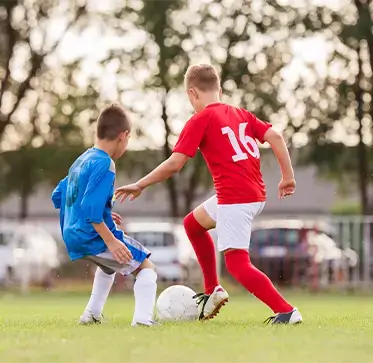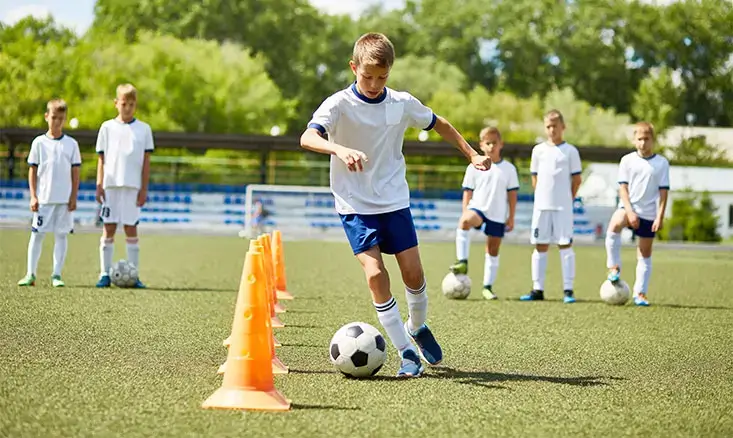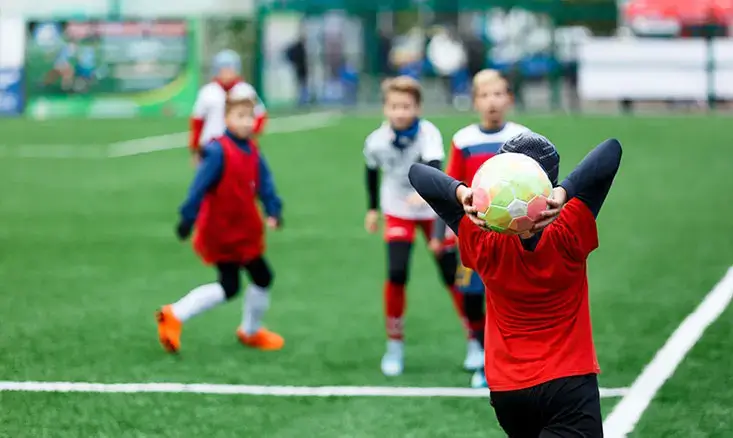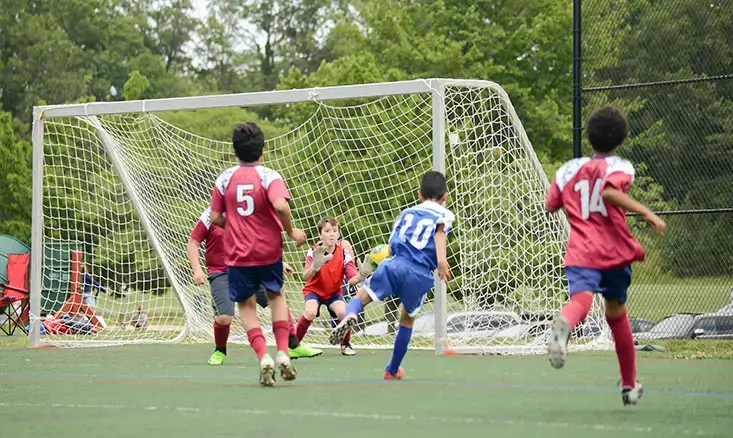15 Youth Soccer First Touch Techniques and Drills

CRFC BLOGS
LATEST BLOGS & NEWSLETTERS
15 Youth Soccer First Touch Techniques and Drills
The first touch in soccer is one of the most critical skills a young player can develop. It refers to the ability to control the ball immediately after receiving it, efficiently setting up the next move. Practicing youth soccer first-touch drills is crucial for maintaining possession, increasing the speed of play, and achieving success at higher levels of competition. Understanding and improving the first touch can transform players’ game, making them more effective and confident on the field.
What is First Touch?
The first touch is the player’s initial contact with the ball upon receiving it. This touch can determine the game’s flow, allowing players to pass, shoot, or move effectively. Good youth soccer first-touch drills include various game scenarios, such as a quick pass to a striker for a goal or a defensive interception leading to a counter-attack. It’s not just about trapping the ball; it’s about controlling it to give you an advantage over your opponent.
Benefits of a Good First Touch
By focusing on developing a good first touch, players can significantly enhance their overall soccer skills, contributing to their individual performance and their team’s success.
1. Improved Ball Control
Precise Movement
A good first touch allows players to direct the ball exactly where they want it to go, facilitating better control over their movements and actions.
Close Possession
By keeping the ball close to their body, players make it more difficult for opponents to steal or intercept it, thus maintaining possession more effectively.
Skill Development
Mastering ball control with the first touch helps players develop other advanced skills like dribbling, feints, and turns.
2. Enhanced Decision-Making Speed
Quick Thinking
With a solid first touch, players spend less time corralling the ball and more time assessing their surroundings and making strategic decisions.
Improved Reaction Time
A well-controlled ball allows for faster reactions to the dynamic changes in a game, whether it’s evading a defender, setting up a pass, or taking a shot.
Better Tactical Choices
By reducing the time needed to control the ball, players can make more informed and effective tactical choices, benefiting the entire team’s play.
3. Better Overall Game Performance
Smooth Gameplay
Consistent good touches contribute to a smoother and more fluid style of play, enhancing the team’s overall performance on the field.
Efficient Movement
With better control from the first touch, players can move more efficiently, making quick passes, accurate shots, and coordinated plays.
Increased Confidence
A player with a reliable first touch gains confidence, which positively affects their overall gameplay and contribution to the team.
4. Enhanced Passing and Shooting Accuracy
Accurate Passes
A good first touch sets up the ball perfectly for the next action, leading to more precise and accurate passes.
Better Shooting Positions
Controlling the ball well on the first touch can create better soccer shooting opportunities, allowing players to position themselves optimally for scoring.
Fluid Transitions
By ensuring the ball is well-controlled, players can transition smoothly from receiving a pass to making a decisive play, enhancing the team’s offensive capabilities.
5. Greater Adaptability and Versatility
Adaptability to Game Situations
Players with a strong first touch can quickly adapt to various game situations, whether they are under pressure, in tight spaces, or need to execute quick transitions.
Versatility in Positions
A good first touch makes players more versatile, allowing them to perform well in different positions and roles on the field.
Enhanced Creativity
With better control and more time to think, players can be more creative in their play, experimenting with different moves and strategies to outmaneuver opponents.

Basic Youth Soccer First Touch Techniques
Developing solid first touch techniques is essential for youth soccer players to control the ball effectively and set up their next move. These techniques being part of youth soccer first touch training focus on different parts of the foot and body, providing a foundation for advanced skills and enhancing overall game performance.
Using the Inside of the Foot
Mastering the use of the inside of the foot is fundamental for young players as it forms the basis for more advanced ball control techniques. This technique is versatile and can be used in various game situations, from receiving a pass to preparing for a shot or a quick dribble.
Broad Surface Control
This is the most common technique for controlling the ball because the inside of the foot provides a large, flat surface, making it easier to cushion and direct the ball.
Body Positioning
Players should position their bodies to meet the ball head-on, with their hips and shoulders square to the ball. This alignment helps absorb the ball’s impact and maintain control.
Cushioning the Ball
To cushion the ball effectively, players should slightly withdraw their foot upon contact, softening the touch to keep the ball close.
Using the Outside of the Foot
This skill is particularly useful in tight spaces where quick, controlled touches are needed to navigate through defenders.
Quick Directional Changes
The outside of the foot is ideal for making swift changes in direction, helping players evade defenders quickly.
Deceptive Moves
This technique can be used to fake out opponents by pretending to go one way before quickly moving the ball in the opposite direction.
Body Angle
Players should angle their bodies slightly away from the ball to effectively use the outside of their foot, creating space and preparing for the next move.
Speed and Agility
Using the outside of the foot can enhance a player’s speed and agility, making it easier to transition from defense to attack.
Aerial Control
Effective aerial control ensures the player maintains possession after receiving high passes, clearances, or crosses, which is crucial for setting up the next play. By bringing the ball down quickly and smoothly, players can prepare for their next move, whether it’s a pass, a dribble, or a shot on goal.
Chest Control
Using the chest to control high balls requires proper body alignment and cushioning. Players should lean back slightly and tense their abdominal muscles to absorb the ball’s impact.
Thigh Control
Controlling the ball with the thigh involves raising the leg to meet the ball at the correct height, then cushioning it down smoothly to the ground.
Foot Control
For high balls that are within reach of the foot, players should aim to meet the ball with the top of their foot, using a soft touch to bring it down.
Using Both Feet
Mastering the use of both feet can significantly enhance a player’s overall soccer abilities, from passing and shooting to dribbling and defending. Regular drills that emphasize using both feet can help players become more comfortable and skilled with their non-dominant foot.
Unpredictability
Opponents find it harder to predict a player’s movements when they are proficient with both feet, making it easier to create scoring opportunities.
Balanced Play
Using both feet ensures a more balanced playstyle, allowing players to control the ball effectively from any angle or position.
Receiving on the Move
This technique requires excellent coordination and balance, as players must control the ball while adjusting their speed and direction. Practicing this skill replicates real-game situations where players are rarely stationary, helping them perform better during actual matches.
Dynamic Control
Players often need to control the ball while on the move, requiring precise timing and touch.
First Touch into Space
Instead of stopping the ball dead, players can direct their first touch into space, allowing them to maintain momentum and prepare for their next action.
Anticipation and Awareness
Players must anticipate where the ball will be and position themselves accordingly, maintaining awareness of their surroundings.
Key Youth Soccer First Touch Drills
Mastering the first touch is essential for young soccer players to improve their ball control and overall gameplay. The following youth soccer first touch drills focus on developing this critical skill, helping players handle the ball more effectively under various conditions and pressures.
Essential Youth Soccer Drills to Master First Touch
Mastering the first touch is crucial for youth soccer players, helping them to control the ball and set up their next moves efficiently. The following are five drills designed to develop first touch for youth soccer players age U8, U10, and beginners. These drills are designed to help youth soccer players develop a reliable and effective first touch, enhancing their overall gameplay and confidence on the field. Regular practice and progression in these drills will ensure players are well-equipped to handle various game situations with ease.
1. Controlling the Ball with the Inside of the Foot
Drill Setup
Create a passing drill where players are paired up about 10-15 yards apart. One player passes the ball to their partner, who must control it with the inside of their foot and then return the pass.
Execution
Focus on using a soft touch to cushion the ball and keep it close. The receiving player should position their body correctly, align their foot with the ball, and slightly withdraw their foot upon contact to absorb the ball’s impact.
Progression
As players become more proficient, increase the distance between them and add variations such as one-touch passing or incorporating movement before receiving the ball.
2. Using the Outside of the Foot Under Pressure
Drill Setup
Arrange players in groups of three, with one player acting as a defender and the other two as attackers. The attackers pass the ball back and forth, with the receiving player using the outside of their foot to control it.
Execution
The defender applies moderate pressure, simulating a real-game scenario. The attacking players must use the outside of their foot to control the ball quickly and change direction to evade the defender.
Progression
Increase the intensity of the defensive pressure and reduce the space in which the attackers can operate, forcing quicker and more precise touches.
3. Aerial Control and Chest Traps
Drill Setup
Players are grouped in pairs, with one player as the passer and the other as the receiver. The passer tosses or kicks the ball towards their partner, who must control it using their chest or thigh.
Execution
The receiving player should focus on using their chest to cushion the ball and bring it to the ground smoothly or using their thigh to control and direct it. Proper body positioning and timing are crucial for effective control.
Progression
Vary the height and speed of the passes, and include movements such as turning after controlling the ball or passing it to a third player immediately after bringing it down.
4. One-Touch Passing with Movement
Drill Setup
Set up a grid of cones to create a small area, and position players in pairs within the grid. The objective is to pass the ball using only one touch.
Execution
Players pass the ball to each other, ensuring they control and redirect it in a single touch. The emphasis should be on accuracy, speed, and maintaining a smooth rhythm.
Progression
Add movement by having players continuously move around the grid while maintaining one-touch passes. This simulates game situations where players are rarely stationary.
5. First Touch into Space
Drill Setup
Create a small playing area with cones and place a few target zones marked by additional cones. Players form lines and take turns receiving a pass from a coach or another player.
Execution
Players must receive the pass and use their first touch to direct the ball into one of the target zones. This drill emphasizes controlling the ball and moving it into space to set up the next action.
Progression
Introduce passive defenders who apply light pressure, forcing players to make quicker decisions. Eventually, progress to active defenders to fully simulate game conditions.

Youth Soccer First Touch Team Drills
Youth soccer players ages 12, U14, and above are engaged in first-touch team drills that challenge their decision-making, movement, and ball control. The following are five drills designed to elevate their abilities. These youth soccer first-touch team drills help players refine their first touch, improve their ball control, and enhance their overall decision-making and movement on the field. Regular practice and progression through these drills will prepare players for the complexities of competitive matches.
1. One Touch Passing Drills
Drill Setup
Players form pairs or small groups within a marked area. Each player stands 10-15 yards apart from their partner or group members.
Execution
Players pass the ball to each other using only one touch. The focus is on quick, accurate passing and maintaining the ball’s movement. Players should constantly adjust their position to receive and redirect the ball efficiently.
Progression
To increase difficulty, reduce the space between players, add more players to the group, or include a moving target for players to pass towards. Introducing defenders who apply pressure can also add a game-like challenge.
2. Give-and-Go Sequences
Drill Setup
Set up a small playing area with cones to mark positions for players. Form groups of three, with two players as attackers and one as a passive defender.
Execution
The first attacker passes the ball to the second attacker and immediately moves into space to receive a return pass (the “give-and-go” sequence). The second attacker should use their first touch to pass the ball back to the moving player.
Progression
Increase the intensity by making the defender more active, forcing attackers to execute the give-and-go sequence under pressure. Incorporate more players to simulate real-game scenarios and encourage quick thinking and movement.
3. Defensive Interception and Distribution
Drill Setup
Create a small grid with cones, with attackers positioned at one end and defenders in the middle. The attackers pass the ball back and forth while the defenders try to intercept.
Execution
Defenders focus on reading the attackers’ passes and intercepting the ball. Once a defender intercepts the pass, they must quickly control the ball and distribute it to a teammate outside the grid, emphasizing a clean and controlled first touch.
Progression
Add additional attackers to increase the passing options and challenge the defenders further. Reduce the space of the grid to simulate more intense game-like pressure, requiring quicker decisions and faster interceptions.

4. Passing and Receiving in Tight Spaces
Drill Setup
Set up a small grid with cones, with players positioned around the perimeter. A few players stand inside the grid, acting as receivers.
Execution
Players on the perimeter pass the ball to the receivers inside the grid, who must control the ball with their first touch and then pass it back out. The focus is on maintaining control in tight spaces and making quick, accurate passes.
Progression
Increase the number of receivers inside the grid to make the space more crowded, adding difficulty. Introduce passive defenders who apply light pressure, gradually increasing their activity level to challenge the receivers further.
5. First Touch Under Pressure with Combination Play
Drill Setup
Set up cones to mark a playing area and position two lines of players facing each other about 20 yards apart. One line acts as passers, and the other as receivers.
Execution
The first player in the passing line sends a pass to the first player in the receiving line, who must control the ball with their first touch and then pass it to a third player making a run. This drill emphasizes controlling the ball under pressure and combining play with teammates.
Progression
Add defenders to apply pressure on the receiving players, forcing them to make quicker decisions and execute more precise touches. Increase the complexity by incorporating more players and additional passing sequences.
Practical Application of Youth Soccer First Touch Techniques
Players use their first touch to control the ball in various situations, such as passing, shooting, or defending. Effective first touches can change the game’s pace, creating opportunities for attacks or solidifying defensive plays. Applying first-touch techniques in real-game situations is crucial for players to utilize their skills effectively under pressure. These techniques help players maintain possession, execute strategic plays, and adapt quickly to dynamic game scenarios, ultimately enhancing their overall performance on the field.
Effective Coaching Tips
Repetition and Consistency in Practice
Coaches should incorporate first-touch drills into every training session, ensuring players get ample opportunity to practice.
Providing Constructive Feedback
Coaches should offer specific feedback to help players improve their technique. They should focus on both what the player is doing well and what can be improved, providing clear, actionable advice.

Conclusion
The first touch is a fundamental skill that can significantly enhance a player’s performance on the field. By understanding its importance and practicing regularly through various drills and techniques, players can improve their ball control, speed of play, and overall effectiveness in games. Coaches play a crucial role in this development by providing consistent practice opportunities and constructive feedback.
FAQs
How to Practice Youth Soccer First Touch?
Practice first touch in soccer by regularly engaging in youth soccer first touch drills such as controlling the ball with the inside of the foot, using the outside under pressure, and aerial control exercises. Consistent practice helps improve ball control and confidence on the field.
How to Get Better at One Touch in Soccer?
To improve at soccer one-touch, practice youth soccer one-touch drills like passing and receiving in tight spaces and one-touch passing with movement. These drills enhance quick thinking and accurate passing.
How to Teach First to the Ball in Youth Soccer?
Teach “first to the ball” in soccer by emphasizing the importance of anticipation and positioning in youth soccer first-touch training. Drills focusing on receiving the ball on the move and directing it into space help players be the first to react and control the ball.
What Makes a Good First Touch in Soccer?
A good first touch in soccer involves controlling the ball effectively on initial contact to set up the next move. This includes using techniques from youth soccer first-touch team drills to maintain possession and create opportunities.
How Can I Practice My First Touch Alone?
You can practice your first touch alone by using a wall for passing and receiving, focusing on first-touch soccer drills for beginners, like controlling the ball with different parts of your foot. Regular practice will help you improve your ball control and overall skill.

Did you find this useful?


